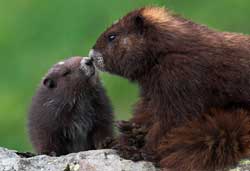The Alpine Resort is a key partner of the Marmot Recovery Foundation, donating the land on which a dedicated Marmot Recovery Center was built to prepare marmots, born in a national zoo-based captive breeding program off-island, for release back to the wild alpine bowls they historically called home. One of those homes is Mount Washington itself, which has consistently hosted the largest surviving wild colony on Vancouver Island, the only place in the world these marmots are found.
This summer, nine captive-born marmots were released at Mount Washington to augment the wild colony living there, which now numbers over 30 marmots.
Throughout the ski season the marmots remain snuggled up, safe and sound in their burrows in hibernation, oblivious to the winter activities taking place around them.
As a matter of fact, it is thought that the presence of the alpine resort may be a key factor in why the wild Mount Washington Marmot colony survived while other more remote colonies nearby in the pristine habitat of Strathcona Park did not. The presence of year-round human activity near the wild marmot colony may have acted as a deterrent to predators and protected the marmots from predator mortality at a time they were particularly vulnerable.
The Marmot Recovery Foundation is working to restore the wild marmot population through an intensive captive breeding and reintroduction program, identified by the Vancouver Island Marmot Recovery Team as the most effective way to save the uniquely Canadian marmot from near extinction.
“This year we’ve begun to see the positive impacts of our earlier releases on the wild population”, said Viki Jackson, executive director of the Marmot Recovery Foundation. “Eleven litters were born in the wild in 2008, up from only three litters in 2007, and seven of those litters involved at least one captive-born released marmot. Those are significant gains.“
“But the real thrill has been the births of the first 2nd generation pups, from pups previously born in the wild from captive-born released marmots” she said. “I know that’s a little hard to follow but when you see 2nd generation animals being born in the wild you can really see you’re getting somewhere.”
While the Vancouver Island Marmots are showing they have the potential for a full recovery they remain dangerously close to extinction with a small and fragmented population of less than 160 marmots in the wild. The goal is a population of between 400-600 marmots in three distinct regions on Vancouver Island.
“It will take a few more years of intensive efforts to safeguard the population but it is a battle against extinction we can win if we have the resources. The support of the public is critical to ensure these little guys make it,” Jackson said.
For more information or to make a donation to help save the Vancouver Island Marmot go to www.marmots.org
